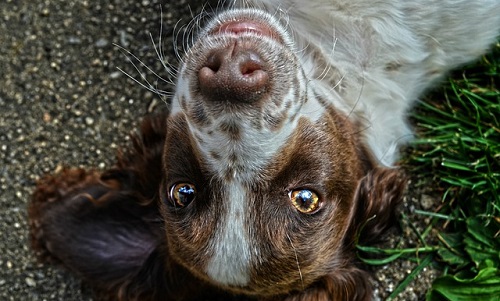A common sign of submissive dog behavior is urinating during inappropriate times. This behavior is not only inconvenient and messy for pet owners, but it’s also a sign of a deeper canine behavioral problem. So what is submissive dog urination?
Submissive dog urination occurs when an animal urinates as a result of canine anxiety, timidness, or acknowledgment of a dominant human or animal. When dogs submissively pee, it is seen as a temporary loss of bladder control. Some will dribble small amounts of urine while others will create much larger puddles.
Submissive dogs may pee when they are touched or greeted. Others will roll onto their backs and urinate when they come into contact with people or other canines. Pet owners usually encounter submissive dog peeing when they return home from work. Dogs are pack animals and have several ways to show an alpha that they accept their role as the leader. The primary way they do this is by avoiding confrontation, but another common method is to roll onto their backs and urinate.
What Causes Submissive Dog Urination?
Submissive dog urination is usually exhibited by anxious, shy, or timid animals with a history of being treated harshly or severely punished. Canines who have an unclear understanding of the rules will become extremely insecure. They will pee submissively and adopt other submissive behaviors in order to avoid punishment. Submissive dog urination is common in puppies, but most will eventually outgrow this behavior. Some dogs will remain shy and anxious as they grow into adults in which submissive urination will become a problem in your home.
Urinary incontinence in dogs is not any more common for certain breeds than others. However, breeds known to be the most submissive include Beagles, Basset Hounds, Golden Retrievers, and Irish Setters. Smaller breeds also tend to be shyer around strangers and may urinate when they encounter people they aren’t familiar with. In addition, older canines usually show more signs of submission than younger pups. Since they aren’t able to react as quickly as they used to, senior dogs can feel threatened in certain situations. Older submissive canines will sometimes shake or urinate when they feel anxious or intimidated.
Submissive dog urination usually occurs in the following situations:
- When a canine is being scolded
- When they are approached or greeted
- When a pup hears a loud noise
- When they are startled
- When they are anxious or intimidated
 Submissive dog peeing is a somewhat standard form of canine communication. They do it to show appeasement in social situations. When a pup urinates in submission, he is attempting to convey that he is not a threat. Urination commonly occurs when dogs become excited or feel intimidated by the presence of people or animals, especially those they are unfamiliar with.
Submissive dog peeing is a somewhat standard form of canine communication. They do it to show appeasement in social situations. When a pup urinates in submission, he is attempting to convey that he is not a threat. Urination commonly occurs when dogs become excited or feel intimidated by the presence of people or animals, especially those they are unfamiliar with.
Submissive urination usually happens when it’s time to greet someone, in new or exciting situations, during playtime, or as a result of physical contact. Some submissive dogs will pee any time they are touched or pet while others will only urinate when they are punished or scolded.
Submissive peeing should be differentiated from other canine conditions that involve urinating at inappropriate times such as excitement urination. Dogs who pee when they get excited may just be exhibiting excitement urination which is very common and will not typically be accompanied by other signs of submissive dog behavior.
Other Submissive Dog Behaviors
When dogs are in situations that trigger submissive urination, they will usually display other signs of submission.
Other signs of submissive dog behavior include:
- Rolling onto their back or side
- Holding their ears flat
- Tucking their tail between their legs
- Grinning submissively
- Avoiding eye contact or breaking eye contact first
- Cowering in the presence of humans
- Avoiding people and animals
- Lowering their heads
- Shaking in fear
- Keeping their eyes partly closed
- Allowing other dogs to paw their shoulders
- Whining or squealing in fear
- Crouching low to the ground
If your dog is displaying multiple signs of submissive behavior in addition to frequent urination, you may be dealing with a submissive dog. However, some of these signs do not necessarily point to a submissive canine on their own.
If your pup greets people with a big, open smile, this is sometimes referred to as a submissive grin. Although it may appear as a sign of aggression, it’s not a threatening display. However, if your dog’s toothy grin is accompanied with a snarl and stiffened posture, this is definitely not submissive behavior. It’s important to never approach a snarling dog. Docile canines will usually display grins with their eyes partially closed in a lowered or crouching position.
How to Correct Submissive Dog Urination
Submissive dog urination is your pet’s way of telling you or other animals that they know who’s boss. As mentioned above, most puppies will outgrow the behavior, if your adult dog continues to urinate in submission, there are some steps you can take to correct it.
The first step in correcting submissive dog urination is to determine what is triggering the behavior. Ultimately, you’ll want to avoid these triggers which will prevent submissive peeing. An important thing to remember when training your dog not to urinate submissively is to avoid dominant gestures in his presence and use positive reinforcement instead of punishment.
Canines communicate with one another through vocalization and body language. It’s natural for them to react to the words, facial expressions, and gestures of humans they come into contact with.
Human behaviors that may appear threatening to submissive dogs include:
- Direct eye contact
- Hovering over them
- Using harsh or excited tones
- Making loud noises
- Physical punishment
- Sudden movement
Most dogs will naturally grow out of submissive urination by about one year of age, but some will never move past the habit. If your adult dog urinates submissively, there are a few things you can try to help minimize the behavior.
- Greet your pup outside, if possible. Have some treats and a favorite toy on hand and toss them in the direction of your pet as he runs up to greet you.
- When you first walk through the door, try to ignore your dog. Wait until your pet has completely calmed down before beginning to interact. When you do greet your pup, remain calm and do not make direct eye contact.
- Squat down or sit on the floor next to your pup and let them initiate contact.
- Approach your pooch from the side instead of head-on.
- Train your canine to sit or heal when he greets visitors. You’ll want to practice these obedience commands in a calm environment before strangers come over.
- Touch your dog under the chin or chest instead of on the ears or top of the head.
- Keep your dog’s environment and daily routine as consistent as possible.
- Reward your pet for confident sitting and standing postures.
- Gradually expose your pup to new situations and people and strive to make these positive experiences.
In addition to the above approaches, there are certain things you should never do with a dog that urinates submissively. Avoid bending over your dog in a dominant stance in situations when he might urinate. When you greet your pooch, don’t hug them or pat them on top of the head. Don’t make direct eye contact with your pet. Instead, look at their back or tail. Avoid scowling, frowning, and vocalizing frustration at your pet, especially after he pees. Most importantly, don’t yell at your dog or punish him when he submissively urinates as this will most likely only make the problem worse.
Other Potential Causes of Frequent Dog Urination
If you notice that your dog is urinating at inappropriate moments, you should rule out other medical conditions or improper training that may be contributing to the action. Before assuming your dog is urinating submissively, talk to your veterinarian about the following common health conditions and occurrences that may cause frequent urination.
Other potential causes of frequent dog urination may include:
- Gastrointestinal upset
- Change in diet
- Urinary tract infection
- Recent canine spay surgery or neuter surgery
- Urinary incontinence
- Abnormal genitalia
- Certain medications
 If you recently changed the type or amount of food you feed your dog, it may be a contributing factor to frequent urination or canine diarrhea. Gastrointestinal upset can have a similar effect. Urinary tract infections can also cause canines to pee more frequently than usual. Urinary incontinence is a medical condition that leads to loss of bladder control and frequent urination. Dogs with urinary incontinence will typically be unaware that they peed. Abnormalities of a canine’s genitalia and certain medications can cause urinary incontinence.
If you recently changed the type or amount of food you feed your dog, it may be a contributing factor to frequent urination or canine diarrhea. Gastrointestinal upset can have a similar effect. Urinary tract infections can also cause canines to pee more frequently than usual. Urinary incontinence is a medical condition that leads to loss of bladder control and frequent urination. Dogs with urinary incontinence will typically be unaware that they peed. Abnormalities of a canine’s genitalia and certain medications can cause urinary incontinence.
In addition to medical conditions, some other behavioral problems unrelated to submissive peeing may be the cause of frequent dog urination.
Behavioral causes of frequent dog urination may include:
- Inadequate house training
- Scent marking
- Separation anxiety
Some dogs urinate during inappropriate times because they have not been adequately house trained. When house training your pet is not completed properly, a dog will likely urinate in your home, especially if he is not given enough outdoor potty breaks. Some dogs who are not house trained will go to the bathroom anywhere in a home, while others will go in certain rooms that are not used very often.
Some canines urinate inside the home as a way of scent marking which involves urinating in small amounts on vertical surfaces. Dogs usually scent mark to claim their “territory” and to let other animals know where they’ve been. Some dogs will scent mark when they are stressed, anxious, or frustrated as well.
If your dog urinates inside every time they are left home alone, it may be a sign of canine separation anxiety. You might notice that your pet seems upset or nervous right before you head out. Dogs with separation anxiety will also typically yelp and whine when their owners get ready to leave home.
Submissive dog urination typically takes place when a canine perceives a threat which may be intentional or unintentional. Intentional threats include an owner harshly scolding or punishing their pet. Unintentional threats could involve dominant behavior such as looking your dog directly in the eyes or startling noises (if your dog is scared of the vacuum cleaner) around your home. Submissive urination is your dog’s way of communicating that he is submitting to the dominance of the perceived threat.
The key to preventing submissive dog urination is building up your pet’s confidence. This can be done by utilizing positive reinforcement and avoiding punishment. Aggression and scolding will typically only worsen the problem of submissive urination. Most importantly, be patient with your pup. Building up a dog’s confidence takes time and commitment. However, with the gentle dedication and kindness of their owners, dogs can overcome their canine phobias or fears and develop into happy, secure animals.




